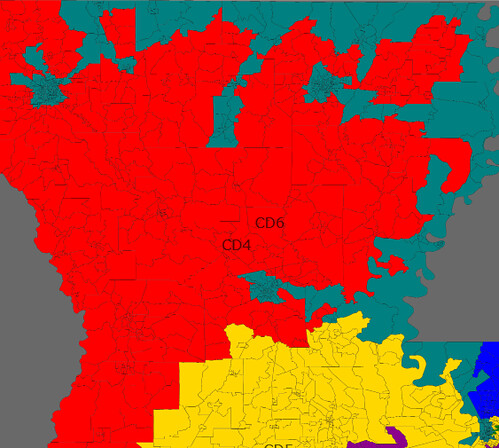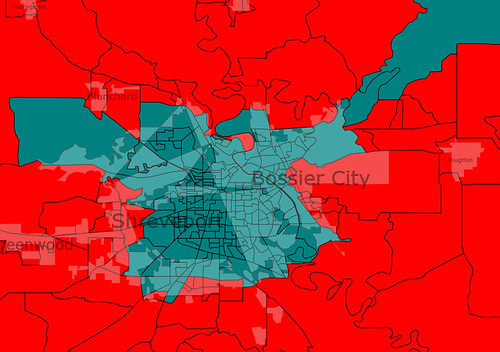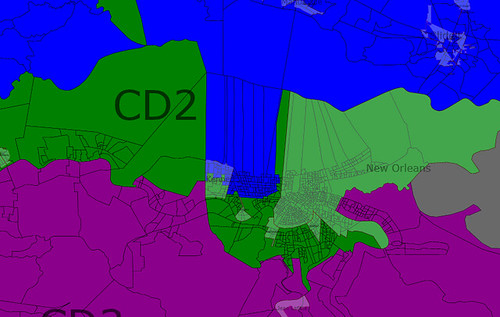Ok, so I decided to take on Texas. My mindset for this map was that Republicans would be controlling it, but they would be exercising rationality, realizing their time of statewide domination may be nearing a close, and that throwing Democrats a few bones now is much better than throwing Democrats the entire map later in the decade. If you don’t think Republicans will wake up and smell the coffee and just gun for a dummymander, get your grain of salt ready now.
Of course, a special thanks goes out to Dave and his amazing Redistricting App for making this all possible.
North Texas:

South Texas:

Zoom-ins
Dallas-Fort Worth:

Houston:

San Antonio/Austin:

In detail:
Texas’s 1st Congressional District (Medium Blue)
-Tyler, Longview, Lufkin
67% White, 17% Black, 14% Hispanic
Texas’s 2nd Congressional District (Dark Green)
-Beaumont, Port Arthur, La Porte
64% White, 17% Black, 16% Hispanic
—Picks up Chambers & east Galveston Counties, along with some of the Whiter parts of the old TX-22’s portion of Harris County, while ceding part of the Spring area to the new TX-34
Texas’s 3rd Congressional District (Purple)
-Most of Plano, McKinney, Allen
65% White, 15% Hispanic, 10% Asian
—This area has grown ridiculously and is rapidly Dem-trending. It does shed some of south Collins County to shore up the TX-32, but staves off the coming demographic disaster by dropping the Garland area as well. To help compensate, it picks up some of exburban Collins County from the TX-4.
Texas’s 4th Congressional District (Red)
-Sherman, Texarkana, Paris
75% White, 11% Hispanic, 11% Black
Texas’s 5th Congressional District (School Bus Yellow)
-West Dallas, most of Mesquite, Most of Garland
57% White, 24% Hispanic, 13% Black
—This picks up most of the Garland area, and while that helps boosts the minority population significantly, it should be more than compensated by the uber-conservative rural population (though it drops some of that as well).
Texas’s 6th Congressional District (Teal)
-College Station, Huntsville, Corsicana
66% White, 18% Hispanic, 14% Black
—I ended up pulling this completely out of Tarrant County, making this an entirely exburban/rural district, which makes it more conservative and helps facilitate the creation of a new conservative-leaning district in south Tarrant County.
Texas’s 7th Congressional District (Light Grey)
-West Houston, Bellaire
58% White, 27% Hispanic
—Picks up some of the Katy area while dropping some Hispanic-majority blocks. The long-term prognosis for keeping this district Republican still isn’t fantastic, but it’s that much better than it was.
Texas’s 8th Congressional District (Steel Blue)
-The Woodlands, Conroe
75% White, 15% Hispanic
Texas’s 9th Congressional District (Cyan)
-Southwest Houston, part of Missouri City
36% Black, 35% Hispanic, 15% White, 12% Asian
—Keeping this plurality African-American was not fun (though admittedly it would have been easier if I weren’t trying to keep Hispanics out of the TX-7). What are the odds this ratio holds out until 2020? Is there precedent for congressional districts transitioning from one protected group until the other?
Texas’s 10th Congressional District (Rose)
-Part of Austin, Pflugerville, Gonzales
64% White, 23% Hispanic
—Pulling out of Harris County doesn’t really help Michael McCaul, but dropping some heavily-Hispanic parts of Austin and picking up several heavily-Republican rural counties and the more conservative parts of the old TX-21’s section of Travis County, so this should be a net-gain. The time is coming when the premise of having a Republican-leaning district taking in a large portion of Austin is ridiculous, but this is probably the best bet for holding on in the meantime.
Texas’s 11th Congressional District (Chartreuse)
-Midland, Odessa, San Angelo
60% White, 35% Hispanic
—With Charlie Stenholm long gone, I went ahead and smoothed out the west Texas districts because none of them are electing a Republican any time remotely soon.
Texas’s 12th Congressional District (Cornflower Blue)
-West Fort Worth, Haltom City
60% White, 29% Hispanic
—Takes in a little more of inner-city Fort Worth, but Granger is (relatively speaking) fairly moderate so it should be a non-issue.
Texas’s 13th Congressional District (Coral Pink)
-Amarillo, Wichita Falls, Pampa
65% White, 26% Hispanic
Texas’s 14th Congressional District (Olive)
-Victoria, Lake Jackson, Seguin
53% White, 36% Hispanic
—Pulls out of Galveston County and picks up more rural counties in Central Texas that the Rio Grande Valley districts have to drop, which does increase the Hispanic population notably. It doesn’t appear to have a major impact on the Republican performance.
Texas’s 15th Congressional District (Orange)
-McAllen, Harlingen, Edinburg
87% Hispanic, 11% White
—This area has grown a ton, so it officially gets to stop being a strip. Neato.
Texas’s 16th Congressional District (Green)
-El Paso, Socorro
81% Hispanic, 14% White
Texas’s 17th Congressional District (Ultramarine)
-Waco, Kileen, Temple
57% White, 22% Hispanic, 17% Black
—The Democratic performance improves significantly here, as the district picks up part of Williamson County and all of Bell County to take the heat off of John Carter and to provide Joe Barton with an entirely non-Metroplex district. I’d guesstimate that McCain still won this district with about 59%-60%, so it hardly leans Democratic (if anything, Chet Edwards might be in more danger from a Republican who can outperform in Bell and Williamson Counties) but it’s not like the Republicans would be interested in helping Edwards out anyway. Realistic? What are your thoughts?
Texas’s 18th Congressional District (Yellow)
-Central Houston
41% Black, 38% Hispanic, 15% White
—Has to shed several Hispanic areas to the TX-29 District to keep African-Americans in the driver’s seat.
Texas’s 19th Congressional District (June Bud)
-Lubbock, Abilene, Big Spring
62% White, 30% Hispanic
—Again, Charlie Stenholm will be but a memory by 2012, so smoothing out these lines and making this district vaguely more Democratic shouldn’t be an issue.
Texas’s 20th Congressional District (Pink)
-Central San Antonio
72% Hispanic, 20% White
Texas’s 21st Congressional District (Maroon)
-North San Antonio, New Braunfels, Universal City
62% White, 28% Hispanic
—Becomes more San Antonio-based than ever taking in most of Bexar County’s predominately White areas. It drops the Austin area and some of its rural Counties.
Texas’s 22nd Congressional District (Chocolate)
-Sugarland, most of League City, part of Missouri City
56% White, 22% Hispanic, 11% Asian
—This drops its portions of Pasadena, La Porte and most of Pearland while picking up more of Galveston County. Should be a bit more Republican overall.
Texas’s 23rd Congressional District (Aqua)
-South San Antonio, Del Rio, Pecos
70% Hispanic, 21% White
—The Hispanic population goes up because it now takes in a greater share of South San Antonio along with a few more Hispanic neighborhoods on the east side. Probably still not totally out of reach for Republicans, but it’ll be a little harder than it was. They could make this district more conservative but they’d probably be kinda hesitant given its legal history.
Texas’s 24th Congressional District (Royal Purple)
-Most of Carrollton, Euless, Grapevine,
62% White, 17% Hispanic, 12% Black
—Dropping the Grand Prairie area is a big help to Kenny Marchant, though this district does have to pick up some kinda-competitive areas in north Arlington and central Fort Worth. Still should be conservative enough to hold up through 2020.
Texas’s 25th Congressional District (Salmon Pink)
-Part of Austin, San Marcos
43% White, 42% Hispanic
—Shrinks considerable, mostly to help Michael McCaul. It might actually be plurality Hispanic by 2010, though it would likely still be dominated by liberal Whites, so I don’t know if it would qualify as a protected district.
Texas’s 26th Congressional District (Gray)
-Denton, Frisco, Lewisville
72% White, 16% Hispanic
—Drops central Fort Worth which, along with the new exburban Collins County portion, which makes it much more conservative. Maybe too much so? Should these lines be altered to somehow take the heat off of Pete Sessions? Is that even possible?
Texas’s 27th Congressional District (Spring Green)
-Corpus Christi, Brownsville, Kingsville
71% Hispanic, 25% White
Texas’s 28th Congressional District (Mauve)
-Laredo, Mission, Eagle Pass
91% Hispanic
—Would a 91% Hispanic district even be legal? This really isn’t that gerrymandered; it moves out of its awkward chunk of Bexar County and consolidates the voices in the Central Rio Grande Valley. But still, as one of (the?) least White districts in the nation, would this count as packing even if it makes geographical sense?
Texas’s 29th Congressional District (Tea Green)
-East & North Houston, Galena Park
63% Hispanic, 21% White, 13% Black
—The percentage of the population which is Hispanic actually drops somewhat in part because of the new TX-33 to the immediate South which takes the old TX-29’s portions of north Pasadena and east Houston, but Hispanics are still the decisive majority.
Texas’s 30th Congressional District (Carnation Pink)
-South Dallas, DeSoto
44% Black, 37% Hispanic, 17% White
—This district had actually slipped to plurality Hispanic as of 2007, so give that I was creating a new Hispanic-protected district next door, the goal here was to make this district plurality African-American again.
Texas’s 31st Congressional District (Cream)
-Round Rock, Copperas Cove, Cleburne
72% White, 18% Hispanic
— The Austin suburbs are looking fairly purple, and it looks pretty plausible that Williamson County will follow the tradition of other suburban areas of “creative class” cities like Clackamas and Washington Counties outside Portland and eastern King County outside Seattle and turn a nice shade of blue as the young, well-educated city dwellers begin to “grow up” and move to suburbs, yet still maintain a lot of their liberal values. The current TX-31 is holding up better than some other Texas districts right now, but I think, if left in the same basic iteration, it would probably be the 2nd or 3rd district to slip out of Republican hands in the next decade after the current TX-32 and maybe the current TX-10. So, in short, this picked up several rural counties from the old TX-11 and TX-17.
Texas’s 32nd Congressional District (Tangerine)
-North Dallas, part of Irving, Richardson
53% White, 29% Hispanic
—More than any other district, the TX-32 was looking at imminent catastrophe. Demographically speaking, as of 2007, Whites were only about 1% more of the population than Hispanics, and Obama made an impressive 46% showing here. The creation of the new TX-33 District allowed the TX-32 to cede several Hispanic areas in west Dallas, south Irving and Farmer’s Branch, and instead picks up some conservative areas of south Collins County (it was needed to shrink in population somewhat anyway). This district will probably still be competitive by the end of the next decade, but that’s better than leaning Democratic, which is would be with the current format.
Whew, anyone still with me? Ok. Let’s look at my ideas for the 4 new districts
Texas’s 33rd Congressional District (Persian Blue)
-Southeast Houston, part of Pasadena, most of Pearland
52% Hispanic, 28% White, 15% Black
—The idea behind this district is take the pressure off of Houston area Republican congressmembers, pretty much all of whom would be in various states of vulnerability in the next several years unless the Hispanic population in their districts stay static or are reduced. It gets kinda meandering at some points, especially as it goes down to take in its Galveston County portion, which actually for the most part is more African-American than Hispanic, but that helps TX-22.
Texas’s 34th Congressional District (Bright Green)
-Katy, Tomball, Brenham
64% White, 22% Hispanic
—Western Harris County is notorious for its sprawl, and this district should lean pretty strongly Republican, especially with its added rural counties. It should be Republican enough that taking in the Hispanic areas that it does from the 9th shouldn’t be a huge deal.
Texas’s 35th Congressional District (Lavender)
-Part of Dallas, part of Grand Prairie, part of Arlington
58% Hispanic, 22% White, 15% Black
—Even if Republicans aren’t as rational as the previous districts would suggest, they’d have to be stunningly foolish and short sided to not put up a Hispanic-majority district in the Dallas area. I’d be surprised if the Justice Department doesn’t order at least one new Hispanic-majority district anyway, and this would be the best place to put it. Anyway, this district vaguely resembles Martin Frost’s old district, taking in part of Arlington and Fort Worth, crossing over into Grand Prairie, west Dallas, south Irving, and then up to Farmer’s Branch and a shameful sliver of north Dallas. Frankly, this district is a little gross, but it takes Pete Sessions, Kenny Marchant, and Eddie Bernice Johnson (or, as far as what Republicans will actually care about, their asses if they don’t protect the African-America community of south and downtown Dallas) out of hot water, so there you go.
Texas’s 36th Congressional District (Gold)
-Part of Fort Worth, part of Arlington, Mansfield
58% White, 23% Hispanic, 13% Black
—Takes in south Fort Worth, south Arlington, a sorta awkward part of southwestern Dallas County, and in to most of rapidly growing Johnson and Ellis Counties. Should lean pretty strongly Republican, though maybe not as strongly as I’d like.
So there you go. Comments? Remember, this map, while certainly favorable to Republicans, assumes some rationality, and that they recognize that throwing us a few bones now will present a world of hurt later, but do you think they’ll be dumb enough to shoot for a dummymander? Assume that Pete Sessions has his finger on the pulse of the Hispanic voice and that when Democrats in Austin move to the suburbs they’ll instantly become flat-out neo-con Texas-secessionists? And what might a compromise map look like if we do manage to pick up the Texas House or Texas Governor?
























